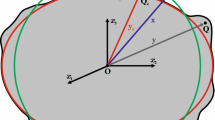Abstract
The direct problem in gravimetry is one of the few areas of applied geophysics where complete, general and fully valid solutions are available. The common issue in the gravimetric direct problem is that there are several different solutions for even simple shaped bodies available throughout the literature. While the direct problem is single-valued, the general solutions (if possible to find analytically) are desired. The aim of the present paper is to bring clarity into the “information noise” which occurs in the literature for the case of the spherical shell/layer. We collected several different solutions and proved their equality (as special cases of the general solution). The differences between these solutions are caused by the symbolism used, but mostly by the different area of validity of each formula. The formulae are discussed and scored on several criteria. The general solutions for the gravitational potential and attraction on the rotational axis of the spherical shell are presented, as well as the solution for the biaxial ellipsoidal layer for comparison.


Similar content being viewed by others
References
Baeschlin, C. F. (1948). Lehrbuch der Geodäsie. Orell Füssli Verlag. in German.
Cassinis, G., Dore, P., & Ballarin, S. (1937). Fundamental tables for reducing gravity observed values. Tipografia Legatoria Mario Ponzio, 11–27.
Hagiwara, Y. (1975). Conventional and spherical Bouguer corrections. Journal of Geodetic Society of Japan, 21, 16–18. in Japanese with English abstract.
Heck, B., & Seitz, K. (2007). A comparison of the tesseroid, prism and point-mass approaches for mass reductions in gravity field modelling. Journal of Geodesy, 81, 121–136.
Jung, K. (1961). Schwerkraftverfahren in der angewandtnen Geophysik (p. 348). Akademische Verlagsgesellschaft, Geest & Portig K.-G. in German.
Karcol, R. (2011). Gravitational attraction and potential of spherical shell with radially dependent density. Studia Geophysica Et Geodaetica, 55, 21–34.
Kühtreiber, N., Kraiger, G., & Meurers, B. (1989). Pilot study for a new Bouguer map of Austria. Österreichische Beiträge Zu Meteorologie Und Geophysik, 2, 51–71.
LaFehr, T. R. (1991). Standardization in gravity reduction. Geophysics, 56, 1170–1178.
Lambert, W. O. (1930). The reduction of observed values of gravity to sea level. Bulletin Géodésique, 26, 107–181.
Lejay, R. P. (1947). Dévellopements moderenes de la gravimétrie. Gauthier-Villars. in French.
MacMillan, D. W. (1930). The theory of the potential. McGraw-Hill Book Company.
Mikuška, J., Pašteka, R., & Marušiak, I. (2006). Estimation of distant relief effect in gravimetry. Geophysics, 71, 59–69.
Quereshi, I. R. (1976). Two-dimensionality on spherical earth—A problem in gravity reductions. Pure and Applied Geophysics, 114, 81–94.
Ramillien, G. (2002). Gravity/magnetic potential of uneven shell topography. Journal of Geodesy, 76, 139–149.
Rempel, G. G. (1981). In A. I. Kalenitskij & V. P. Smirnov (Eds.), Methodological recommendations for accounting for earth’s relief in gravimetry. Siberian Research Institute of Geology, Geophysics and Mineral Resources, 12–13 (in Russian).
Talwani, M. (1973). Computer usage in the computation of gravity anomalies. In B. A. Bolt (Ed.), Geophysics Methods in computation physics (Vol. 13, pp. 343–389). Academic Press Inc.
Acknowledgements
This work was supported by the project of Slovak Grant Agency under contract APVV-19-0150.
Author information
Authors and Affiliations
Corresponding author
Additional information
Publisher's Note
Springer Nature remains neutral with regard to jurisdictional claims in published maps and institutional affiliations.
Appendices
Appendix A
The non-symmetrical case means that the boundaries of the variable φ are set to be arbitrary, i.e. \(\varphi_{1} > 0\) and \(\varphi_{2} < 2\pi\), which means that the source body is the cut of the spherical ring/layer. The resultant vector g is not oriented in the direction of the polar axis but is pointed in the direction given by \(\frac{{\varphi_{2} - \varphi_{1} }}{2}\), according to the symmetry of the task. While the coordinate \(\varphi^{\prime}\) of the calculation point (located on the polar axis) is indeterminable directly, it has to be chosen as \(\frac{{\varphi_{2} - \varphi_{1} }}{2}\) to obtain the correct orientation of the resultant g. The integrations (3) are not solvable analytically in such case, but we can, at least, calculate the \(\left| {\mathbf{g}} \right|\), if the spherical segment is shifted to the position for which \(\frac{{\varphi_{2} - \varphi_{1} }}{2} = 0\). Now, the size of the body is not changed, but the g consists only of the components \(V_{z}\) and \(V_{{\vartheta^{\prime}}}\), and so, the \(\left| {\mathbf{g}} \right|\) can be obtained. The component Vz is already known (Eq. 10), so the task is reduced to the search for the expression of \(V_{{\vartheta^{\prime}}}\):
\(A = \rho^{2} - 2\rho z\cos \vartheta + z^{2}\), \(F\left[ {\frac{\vartheta }{2},k} \right]\) is an elliptic integral of the first kind, \(E\left[ {\frac{\vartheta }{2},k} \right]\) is an elliptic integral of the second kind, \(k = - \frac{4\rho z}{{\left( {\rho - z} \right)^{2} }}\). Note that, despite the fact that the “shifted” values of variable φ are substituted, the result of the integration can be rewritten with help of the original values φ1 and φ2.
Appendix B
Limit of Eq. (6):
where \(A = \rho^{2} - 2\rho z\cos \vartheta + z^{2}\).
All the terms which contain the logarithm function are zero, as well as terms with \(z^{2} \left( {2 - 3\cos^{2} \vartheta } \right)\sqrt A\). The limit is then reduced to:
This limit is divided into sum of two limits which are solved separately, and finally we have:
Rights and permissions
About this article
Cite this article
Karcol, R. Gravitational Potential and Attraction of a Spherical Shell: A Review. Pure Appl. Geophys. 178, 4389–4400 (2021). https://doi.org/10.1007/s00024-021-02876-y
Received:
Revised:
Accepted:
Published:
Issue Date:
DOI: https://doi.org/10.1007/s00024-021-02876-y




